Teriparatide Peptide Mapping Analysis by LC-UV-MS
Jessie Zhixin Miao1, Uma Sreenivasan1
1 Round Rock, TX, USA
Peptide Mapping workflow for Teriparatide
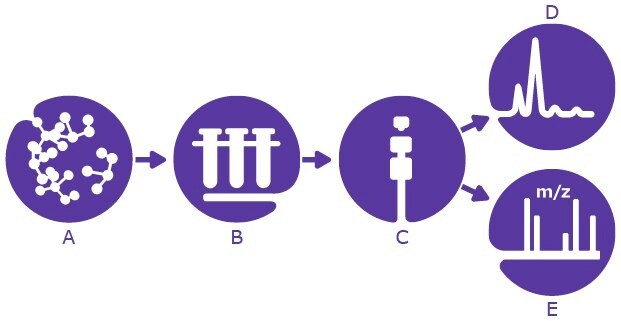
A complete workflow by LC-UV-MS has been developed for teriparatide peptide mapping with 100% sequence coverage. The workflow offers the following:
- Step-by -step instructions for enzyme digestion of teriparatide
- Chromatography conditions on five Supelco® columns to separate teriparatide digestion fragments
- Identification of teriparatide digestion fragments with high accuracy on high resolution, accurate mass QTOF mass spectrometer
Section Overview
- Introduction
- Experimental Procedure
- LC-UV-MS System Setup and Data Analysis
- Data Analysis
- Results and Discussion
- BIOshell™ Peptide Column, 160 Å, C18, 150 x 2.1 mm, 2.7 µm
- Chromolith® High Resolution RP-18 Endcapped Column, 100 x 2.00 mm
- Chromolith® RP-18 endcapped, 100 mm × 4.6 mm
- Ascentis® Express Phenyl-Hexyl Column, 100 × 3.0 mm, 2.7 μm
- Ascentis® Express F5 Column, 100 × 3.0 mm, 2.7 μm
- Conclusions
- Related Products
Introduction
Peptide mapping is a widely used analytical technique to examine primary structures and post-translational modifications (PTMs) of biopharmaceuticals.1, 2 The general workflow is a bottom-up methodology including enzyme digestion followed by separation of the resulting peptide fragments and analysis via ultraviolet (UV) and/or mass spectrometry (MS).1 The major use of the peptide mapping technique is to confirm the primary structure and thereby the identity of the analyte by the amino acid sequence. In the quality control (QC) environment, identity is confirmed by peptide mapping and comparing the sample map to a reference standard map in terms of the peak retention time, peak height and resolution.1 A difference between the sample and reference standard may indicate a change in, or degradation of, the drug substance/product.1 When coupled with mass spectrometry, the mass difference can be used to identify the type of degradation or modification (e.g. oxidation, deamidation and glycosylation of biomolecules).1, 2
Teriparatide is a recombinant form of parathyroid hormone (PTH) used in the treatment of osteoporosis. It consists of the first 34 amino acids (N-terminal) which is the bioactive portion of the hormone, also called rhPTH (1-34).3 It is a single-chain linear polypeptide without any post-translational modifications. This molecule, with the active sequence of endogenous PTH, promotes the remodeling of bone through binding and activation of the PTH-R1 receptor.4 The originator product of Forteo® from Eli Lilly was approved by US Food and Drug Administration (FDA) in November 2002 and European Medicines Agency (EMA) in June 2003. Since the patents on Forteo® expired in August 2019, biosimilars of teriparatide have been approved or are under development.
In this application note, a complete workflow for teriparatide peptide mapping by LC-UV-MS was developed on an Agilent 6545 XT AdvanceBio Q-TOF system. USP teriparatide standard and teriparatide sample were digested by Endoproteinase Glu-C according to the USP monograph method conditions. The resulting fragments were separated on multiple Supelco® columns including BIOshell™ 160 Å Peptide C18 (150 mm × 2.1 mm, 2.7 μm), Chromolith® RP-18e (100 mm × 4.6 mm), Chromolith® High Resolution RP-18e (100 mm × 2.0 mm), Ascentis® Express Phenyl-Hexyl (100 mm × 3.0 mm, 2.7 μm), and Ascentis® Express F5 (100 mm × 3.0 mm, 2.7 μm).
Experimental Procedure
Reagent Preparation
- 20 mM Sodium Phosphate Buffer
A solution of 20 mM of sodium phosphate buffer is prepared by combining sodium phosphate monobasic and sodium phosphate dibasic heptahydrate together in water to reach the final concentration of 0.52 mg/mL sodium phosphate monobasic and 4.34 mg/mL sodium phosphate dibasic heptahydrate. [E.g., dissolve 0.104 g of sodium phosphate monobasic and 0.868 g of sodium phosphate dibasic heptahydrate in 200 mL of HPLC grade water.] - Enzyme Solution
Add 400 µL of HPLC grade water to a vial containing 100 units of Endoproteinase Glu-C, from Staphylococcus aureus V8, and mix well. This solution is stable for 72 h when stored in the refrigerator (2-8 ˚C). - Mobile Phase A: 0.1% TFA in water
Add 1 mL of trifluoroacetic acid (TFA) into 1000 mL of water. Mix well. - Mobile Phase B: 0.1% TFA in acetonitrile: water (60:40, v: v)
Mix 1 mL of trifluoroacetic acid (TFA) to 600 mL of acetonitrile and 400 mL of water. Mix well.
Sample Preparation
A. Teriparatide (USP) Standard Preparation
- Bring the USP teriparatide reference standard vial to room temperature.
- Open the USP teriparatide vial which typically contains about 1 mg of teriparatide (free base). Based on the exact amount in COA, add corresponding amount of 20 mM of sodium phosphate buffer using a positive displacement pipette to generate a 1.5 mg/mL of teriparatide reference standard (RS) solution without further weighing.
- Mix USP teriparatide RS solution with the enzyme solution at a teriparatide to protease ratio of 10:1. Mix well.
- Incubate the USP teriparatide RS and enzyme at 37 ˚C for 18-24h in a heat block to keep the temperature constant.
- Quench the digestion by adding mobile phase A (0.1% TFA in water) to reach a final teriparatide concentration of approximately 0.25 mg/mL. This solution is stable for 72 hours when stored at 2-8 ˚C.
- Transfer this solution to an autosampler vial for LC-UV-MS analysis. Or transfer a portion of this solution to an autosampler vial and store the remaining amount in a freezer for up to 1 month for future analysis.
B. Teriparatide Sample Preparation
- Bring the vial containing about 1 mg of lyophilized teriparatide to room temperature.
- Add 20 mM of sodium phosphate buffer using a positive displacement pipette and mix well to reach a teriparatide concentration of 1.5 mg/mL.
- Mix this solution with enzyme solution to achieve a teriparatide to protease ratio of 10:1. Mix well.
- Incubate teriparatide solution with enzyme at 37 ˚C for 18-24h in a heat block to keep the temperature constant.
- Quench the digestion by adding mobile phase A (0.1% TFA in water) to reach a final teriparatide concentration of approximately 0.25 mg/mL. This solution is stable for 72 hours when stored at 2-8 ˚C.
- Transfer this solution to an autosampler vial for LC-UV-MS analysis. Or transfer a portion of this solution into an autosampler vial and then store the remaining amount in a freezer for up to 1 month for future analysis.
C. Blank Preparation
- In a 1.5 mL microcentrifuge tube, combine 20 mM of sodium phosphate buffer with enzyme solution in the same portions used for the Standard solution and Sample solution. Mix well.
- Cap the vial and incubate at 37 ˚C for 18-24 hours, in a heat block to keep the temperature constant.
- Quench the digestion by adding the same volume of mobile phase A (0.1% TFA in water) as the Standard solution and Sample solution and mix well.
- Transfer this solution to an autosampler vial for LC-UV-MS analysis.
LC-UV-MS System Setup and Data Analysis
The essential settings of the LC-UV-MS chromatography system applied in the analysis of teriparatide peptide mapping are listed in Table 1 and Table 2 below.
Data Analysis
Data analysis for LC-UV and LC-MS was processed through Agilent MassHunter Qualitative Analysis 10.0 software. Digested teriparatide fragments were identified by comparing the m/z value from the extracted MS spectra to the Expasy teriparatide Glu-C digestion fragment database. The LC-UV separation of the teriparatide fragments was compared with USP teriparatide standard as well as with USP teriparatide standard certificate of analysis.5
Results and Discussion
For each run of the digested teriparatide sample, a USP teriparatide standard digest was injected as a system suitability check to evaluate column and system performance. The LC-UV requirements for the system suitability sample were that resolution between fragment III and I is no less than (NLT) 1.5 and tailing factor for fragment IV is no more than (NMT) 2.3. All five digestion fragments found should match the chromatogram provided with USP certification. The retention time ratio between the USP teriparatide standard and the teriparatide sample should be within the range of 1.00±0.03.
Here, we included a second dimension of detection, by mass spectrometry, to confirm the digestion resulting fragments. One hundred percent sequence coverage was achieved with this digestion protocol. All five Supelco columns evaluated here showed adequate separation of teriparatide fragments.
BIOshell™ Peptide Column, 160 Å, C18, 150 x 2.1 mm, 2.7 µm
Digested teriparatide USP standard, sample, and blank were analyzed on Agilent 6545 XT AdvanceBio QTOF LC-UV-MS system with a BIOshell™ Peptide 160 Å, C18 column (150 mm x 2.1 mm, 2.7 µm). USP teriparatide standard was run as a system suitability sample before injection of the teriparatide sample. The HPLC gradient is shown in Figure 1 along with LC-UV chromatograms for USP teriparatide standard and sample solution. All five fragments were identified by comparing to the USP teriparatide certificate. Resolution between fragment III and I is 8.4 which meets the USP monograph criteria of NLT 1.5.5 Tailing factor for fragment IV is 1.1 which meets the USP monograph4 criteria of NMT 2.3 as shown in Table 2. The retention time ratio between USP standard and the sample were all within the criteria 1.00 ± 0.03 (Table 2). One unknown peak, shown in USP teriparatide certificate as well, eluted in front of Fragment II with retention time at 21.48 min was used for Fragment II peak resolution calculation in Table 2.
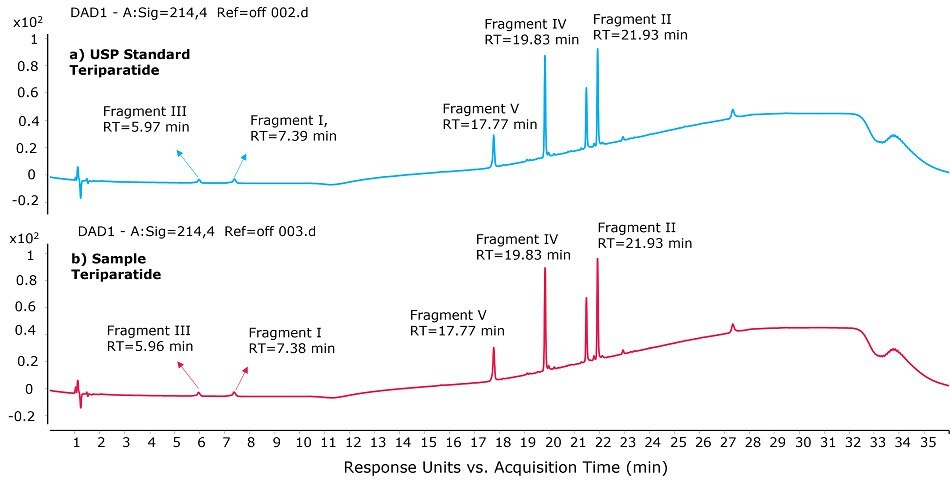
Figure 1.LC-UV chromatograms of teriparatide fragments resulting from Glu-C digestion on BIOshell™ Peptide 160 Å, C18, 150 mm x 2.1 mm, 2.7 µm. a) USP teriparatide standard, b) teriparatide sample. Flow rate: 0.3 mL/min, column temperature: 40 °C.
A second dimension identification of the five fragments was conducted by extracting the mass spectra to match with Expasy PeptideMass database for teriparatide Glu-C digestion.6 The m/z values of each fragment for both the USP standard and sample are shown in Figure 2a and Figure 2b listed following the elution order which proves the 100% sequence coverage of teriparatide from Glu-C digestion. The agreement further confirms that the teriparatide sample matches the USP standard.


Figure 2.Mass spectra for the five peptides from teriparatide Glu-C digestion on BIOshell™ Peptide 160 Å, C18, 150 x 2.1 mm, 2.7 µm column, a) teriparatide USP standard, b) teriparatide sample.
Table 3 shows the mass accuracy of the five measured/deconvoluted fragments from Glu-C digestion compared to the theoretical calculated value from Expasy PeptideMass.6 The deconvoluted mass for all five fragments from both the USP teriparatide and the sample teriparatide is very consistent to the theoretical monoisotopic mass with mass errors less than 2 ppm.
Chromolith® High Resolution RP-18 Endcapped Column, 100 x 2.00 mm
Teriparatide peptide mapping was done on a Chromolith® High Resolution RP-18 endcapped column (100 x 2.00 mm). The same mobile phases were used as on the BIOshell™ column above but with an optimized gradient as shown in Figure 3. Resolution between fragment III and fragment I in system suitability sample is 3.9 and the tailing factor for fragment IV is 2.1 (Table 4), which both meet USP monograph acceptance criteria. The retention time ratio between the USP standard vs teriparatide sample is in the range of 0.99-1.00 (Table 4) which is within the USP criteria of 1.00 ± 0.03.
The LC-MS trace of the five fragments confirms the elution order and the fragment sequence is consistent with the theoretical value from Expasy database (data not shown).

Figure 3.Chromatogram of teriparatide Glu-C digestion fragments separation on Chromolith® High Resolution 18-e, 100 x 2.00 mm, a) LC-MS, b) LC-UV. Flow rate: 0.3 mL/min, column temperature: 40 °C.
Chromolith® RP-18 endcapped, 100 mm × 4.6 mm
Teriparatide peptide mapping was also done on a Chromolith® RP-18 endcapped column (100 x 4.6 mm). The same mobile phases were used as before but with the gradient further optimized as shown in Figure 4. In system suitability sample, resolution between fragment III and fragment I is 4.8 and the tailing factor for fragment IV is 1.7 (Table 5) meeting USP monograph acceptance criteria. The retention time ratio between the USP standard vs teriparatide sample is rounded to 1.00 (Table 5) showing the retention consistency between USP standard and sample teriparatide. Column performance was not as good as the Chromolith® High Resolution RP-18 100 mmx 2.6 mm endcapped column and further optimization maybe required.
LC-MS extracted spectra of the five fragments confirms the elution order, and the observed m/z values are consistent with theoretical values from Expasy (data not shown here).
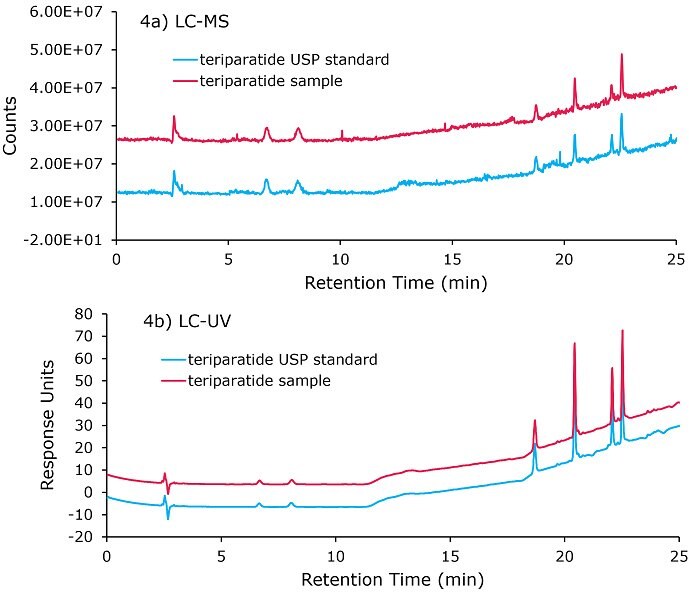
Figure 4.Chromatogram of teriparatide Glu-C digestion fragments separation on Chromolith® 18-e 100 x 4.6 mm, a) LC-MS, b) LC-UV. Flow rate: 0.6 mL/min, column temperature: 40 °C.
Ascentis® Express Phenyl-Hexyl Column, 100 × 3.0 mm, 2.7 µm
Teriparatide peptide mapping was done on an Ascentis® Express Phenyl-Hexyl column (100 x 3.0 mm, 2.7 μm). The same mobile phases, 0.1% TFA in water and 0.1% TFA in acetonitrile/water (60:40, v: v) were used as above but with further gradient optimization. The system suitability injection of USP teriparatide standard yielded resolution between fragment III and fragment I of 2.6 and a tailing factor for fragment IV of 1.4 (Table 6), meeting USP monograph acceptance criteria. The retention time ratio for fragment V, IV, and II between USP standard and teriparatide sample all rounded to 1.00 (Table 6). Fragment III and I retention ratios, between USP standard and teriparatide sample, were 1.17 and 1.20, which were out of the USP monograph criteria. This may have been caused by a system equilibration issue since these two fragments are very polar (Figure 5). However, LC-MS spectra were used to confirm the identity of the five fragments and m/z values are consistent with theoretical values from Expasy (data not shown). Therefore, Ascentis® Express Phenyl-Hexyl is capable of the analysis of teriparatide peptide mapping with adequate resolution and peak shapes.
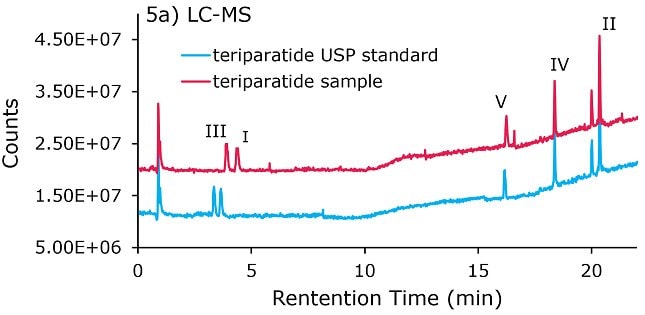
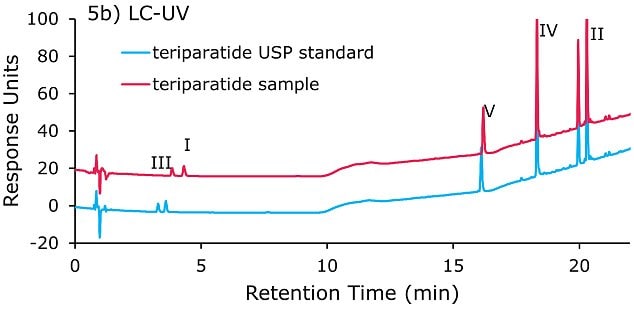
Figure 5.Chromatogram of teriparatide Glu-C digestion fragments separation on Ascentis® Express Phenyl-Hexyl column (100 x3.0 mm, 2.7 µm). a) LC-MS, b) LC-UV. Flow rate: 0.5 mL/min, column temperature: 40 °C.
Ascentis® Express F5 Column, 100 × 3.0 mm, 2.7 µm
Teriparatide enzyme digests were evaluated on an Ascentis® Express F5 column (100 x 3.0 mm, 2.7 μm) as well. Again, the same mobile phases were used as above with the gradient further optimized. System suitability injection of USP teriparatide standard generated peak resolution between fragment I and fragment III was 13.9 (Table 7) meeting USP monograph acceptance criteria well. The tailing factor for fragment IV is 2.6, which is slightly higher than the USP monograph criteria of 2.3 (Table 7). On this column, the elution orders between fragment III, fragment I, the unknown peak, and fragment II are different from the columns used above. Peak identification was confirmed by MS results shown in Figure 7. Spectra for each of the fragment peaks was extracted and the observed m/z compared to the Expasy database for teriparatide Glu-C digestion. Comparing the USP teriparatide standard and the sample teriparatide, the retention time ratios for all five fragments all rounded to 1.00 (Figure 6 and Table 7).
The Ascentis® Express F5 column provided adequate resolution for fragment III and I which is the most challenging separation in teriparatide peptide mapping. Fragment elution order on Ascentis® Express F5 is different from the C18 columns and the Phenyl-Hexyl column which indicates Ascentis® F5 would provide alternative selectivity for teriparatide peptide mapping work. Peak shapes on the Ascentis® Express F5 were not as good as with the other columns under the conditions tested. Optimization of chromatographic conditions to improve the peak shape may prove beneficial.
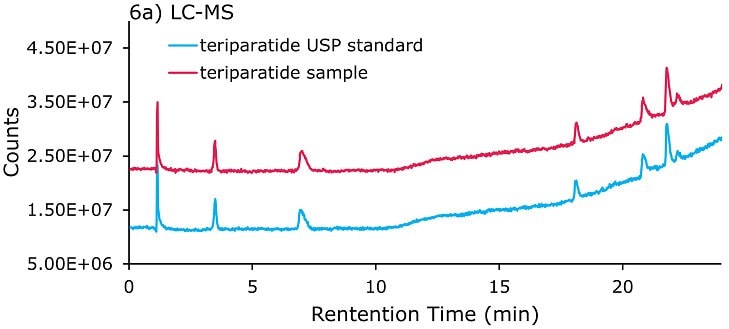
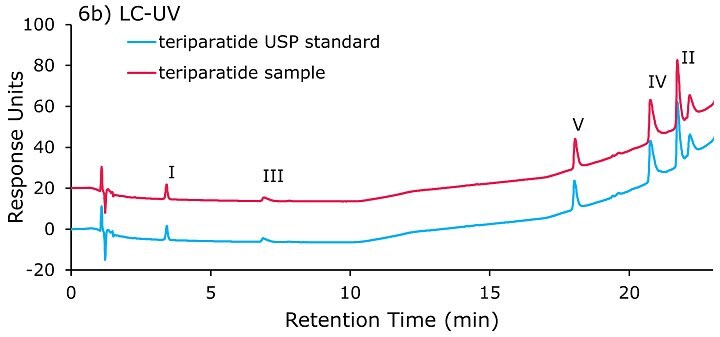
Figure 6.Chromatogram of teriparatide Glu-C digestion fragments on Ascentis® Express F5 column (100 x 3.0 mm, 2.7 µm), a) LC-MS, b) LC-UV. Flow rate: 0.4 mL/min, column temperature: 40 °C.
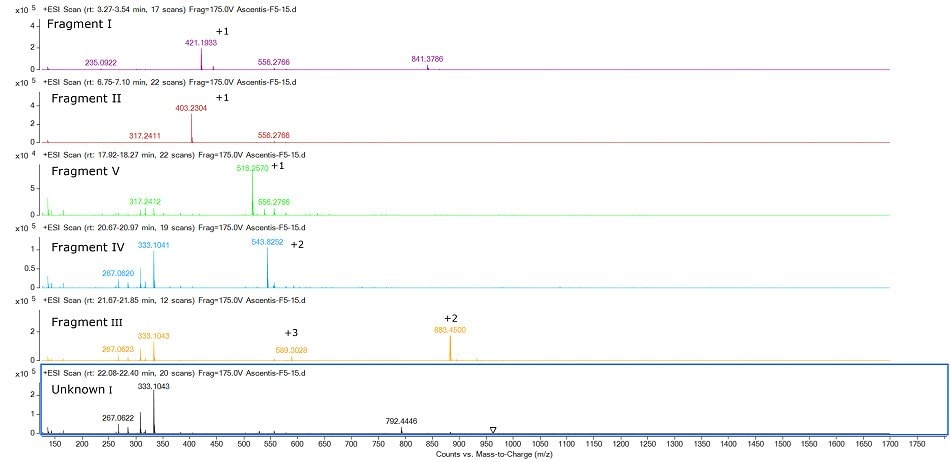
Figure 7.Mass spectra for the five fragment peptides from Glu-C digestion of teriparatide sample on Ascentis® Express F5.
Conclusions
A complete LC-UV-MS workflow has been developed for peptide mapping of teriparatide. This work illustrates the utility of orthogonal column selectivity and LC-UV-MS in peptide mapping analyses, as a means of confirming product identity and sequence coverage. Such approaches maybe useful in development of biosimilars and in monitoring lot to lot variations in manufacturing of peptide and protein drugs. The current USP compendial methods is LC-UV based. Here we show both the LC-UV and LCMS data to identify the peptide fragments detected in the LC-UV using HRMS. Modifications to column dimensions and gradients in compendial methods may require additional validation work. The workflow reported herein offers the following:
- System suitability testing with a USP teriparatide standard
- A step-by-step teriparatide digestion protocol using Endoproteinase Glu-C
- 100% sequence coverage
- Five options for LC column separation of teriparatide digestion resulting fragments
- Complete list of all reagents, consumables, columns, and related products
A complete LC-UV-MS workflow has been developed for teriparatide peptide mapping. USP teriparatide standard served as a system suitability sample to evaluate the teriparatide digestion. A detailed enzyme digestion protocol, to achieve 100% sequence coverage, is provided herein. Five different columns, listed in the HPLC column product list, have been evaluated based on USP monograph LC-UV criteria, as well as on mass spectrometry to confirm the peptide fragments identification. BIOshell™ 160 Å Peptide C18, Chromolith® RP-18e, Chromolith® High Resolution RP-18e, and Ascentis® Express Phenyl-Hexyl columns all showed ample separation of the five digest fragments, with sufficient resolution and tailing factors to pass USP criteria. The Ascentis® Express F5 showed different elution orders for fragment III and fragment I, the unknown peak and fragment II, compared with the first four columns, indicating that it could be used as an alternative for different selectivity.
References
To continue reading please sign in or create an account.
Don't Have An Account?